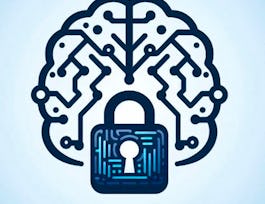In "Introduction to AI for Cybersecurity," you'll gain foundational knowledge of how artificial intelligence (AI) is transforming the field of cybersecurity. This course covers key AI techniques and how they can be applied to enhance security measures, detect threats, and secure digital systems. Learners will explore hands-on implementations of AI models using tools like Jupyter Notebooks, allowing them to detect spam, phishing emails, and secure user authentication using biometric solutions.



Introduction to AI for Cybersecurity
This course is part of AI for Cybersecurity Specialization

Instructor: Lanier Watkins
Sponsored by PKO BP
Recommended experience
What you'll learn
Use AI techniques to detect and mitigate various cyber threats, protecting digital assets and data.
Develop and apply machine learning models to identify, classify, and filter spam and phishing emails.
Implement AI-driven biometric solutions like keystroke dynamics and facial recognition to enhance user authentication security.
Skills you'll gain
- Artificial Intelligence and Machine Learning (AI/ML)
- Authentications
- Threat Management
- Email Security
- Applied Machine Learning
- Machine Learning
- Network Security
- Threat Detection
- Identity and Access Management
- Statistical Machine Learning
- Machine Learning Algorithms
- Machine Learning Methods
- Computer Science
- Cybersecurity
Details to know

Add to your LinkedIn profile
9 assignments
September 2024
See how employees at top companies are mastering in-demand skills

Build your subject-matter expertise
- Learn new concepts from industry experts
- Gain a foundational understanding of a subject or tool
- Develop job-relevant skills with hands-on projects
- Earn a shareable career certificate


Earn a career certificate
Add this credential to your LinkedIn profile, resume, or CV
Share it on social media and in your performance review

There are 4 modules in this course
This course will guide you through the ML development process and its vital applications in combating cyber threats. We’ll explore the challenges posed by technological advancements, examine AI’s role in spam filtering and email threat detection, and implement key algorithms like decision trees and Naïve Bayes. Additionally, you’ll learn how biometric solutions, such as keystroke dynamics and facial recognition, can enhance user authentication security.
What's included
2 readings
In this module, we will discuss the background of artificial intelligence (AI) and provide a brief overview. Also, in this module and every module, we will take a hands-on approach to learning how to use AI for cybersecurity.
What's included
2 videos3 readings3 assignments
In this module, we shall discuss the detection of email threats using AI. Also, we will implement hands-on examples of the use of various ML techniques to detect email threats such as perceptron for spam filtering, support vector machine for spam filtering, regression and decision tree algorithms for spam filtering, and the use of Naïve Bayes ML algorithm and natural language processing for spam filtering.
What's included
5 videos3 readings3 assignments
In this module, we will discuss the background of threats against user authentication. Also, we will explore hands-on implementations of fake login detection analytics using biometrics.
What's included
2 videos3 readings3 assignments1 ungraded lab
Instructor

Offered by
Why people choose Coursera for their career




Recommended if you're interested in Information Technology

Coursera Instructor Network

Johns Hopkins University

Google Cloud

Edureka

Open new doors with Coursera Plus
Unlimited access to 10,000+ world-class courses, hands-on projects, and job-ready certificate programs - all included in your subscription
Advance your career with an online degree
Earn a degree from world-class universities - 100% online
Join over 3,400 global companies that choose Coursera for Business
Upskill your employees to excel in the digital economy


